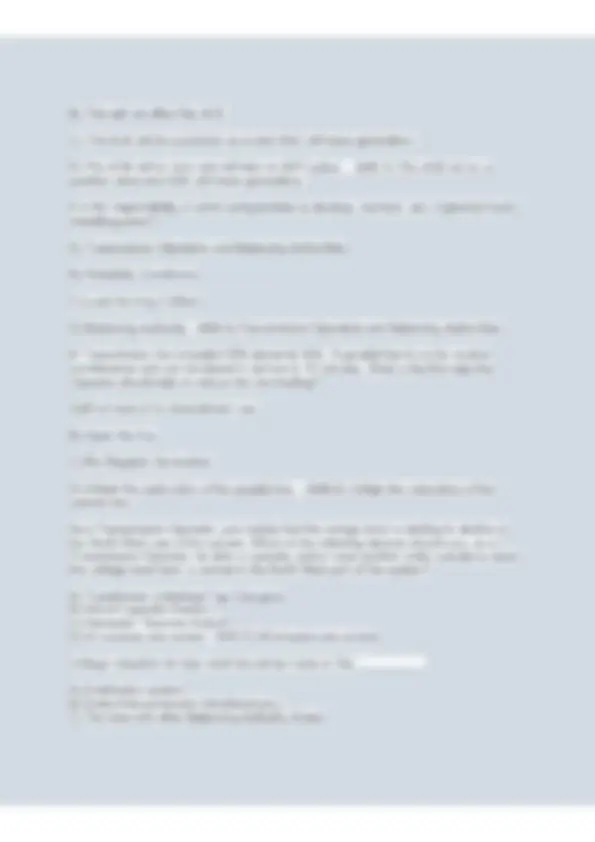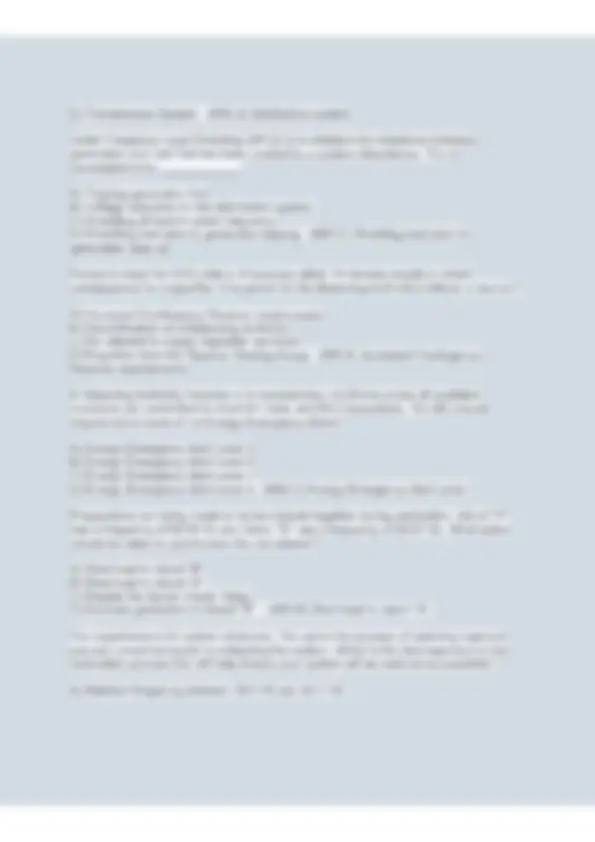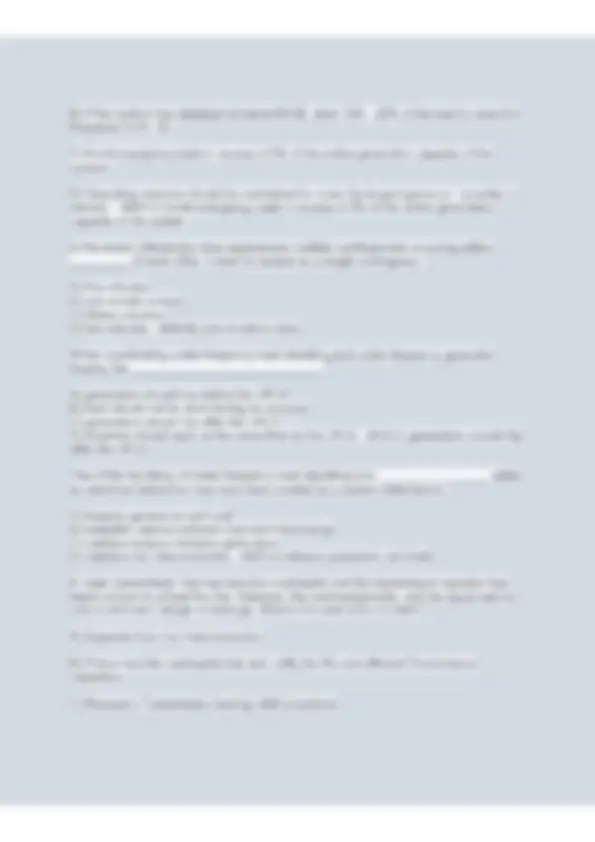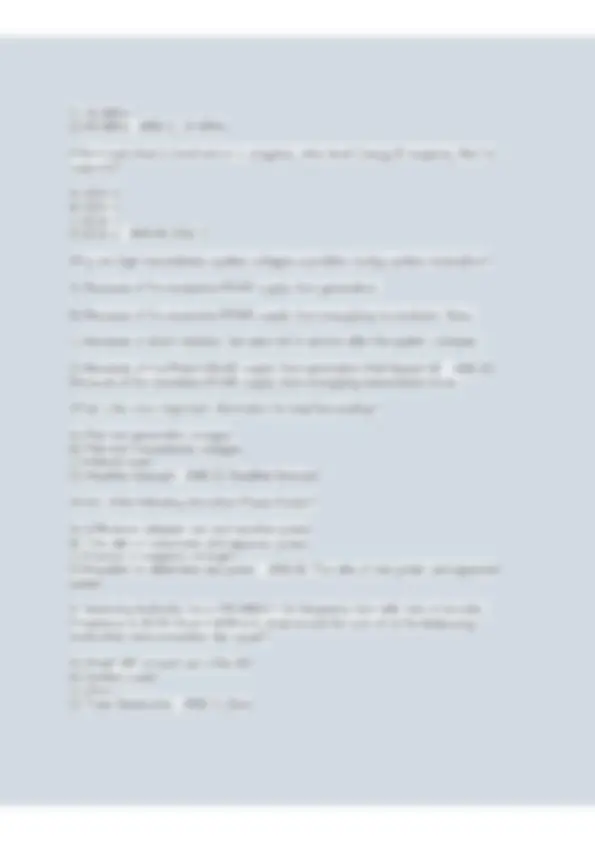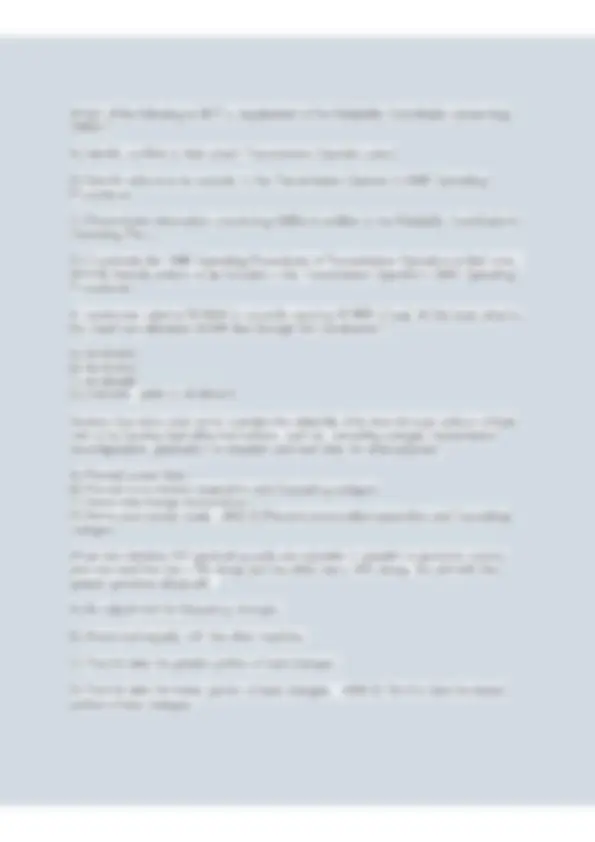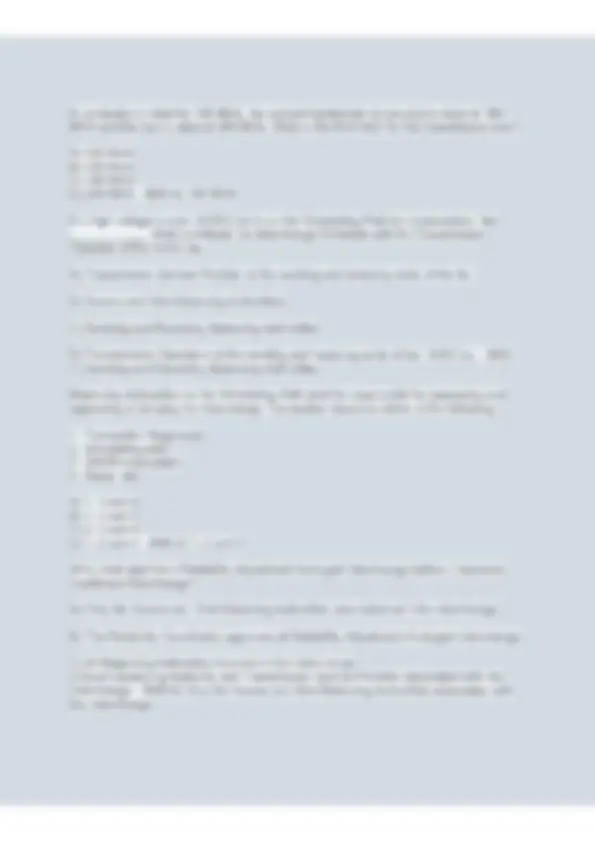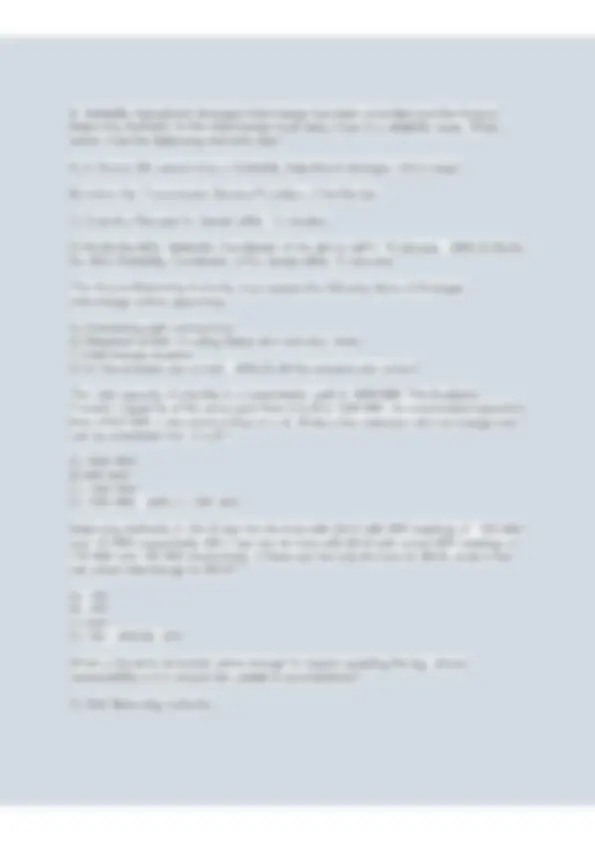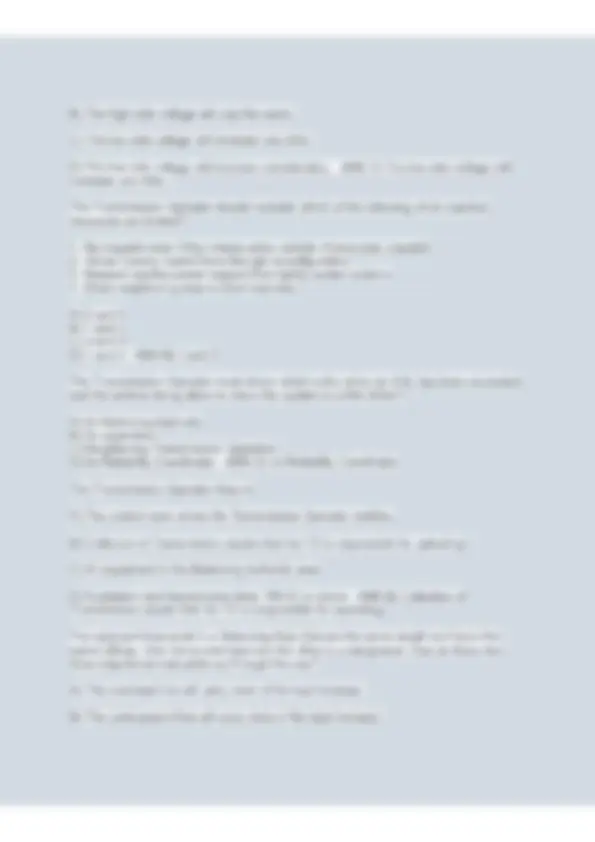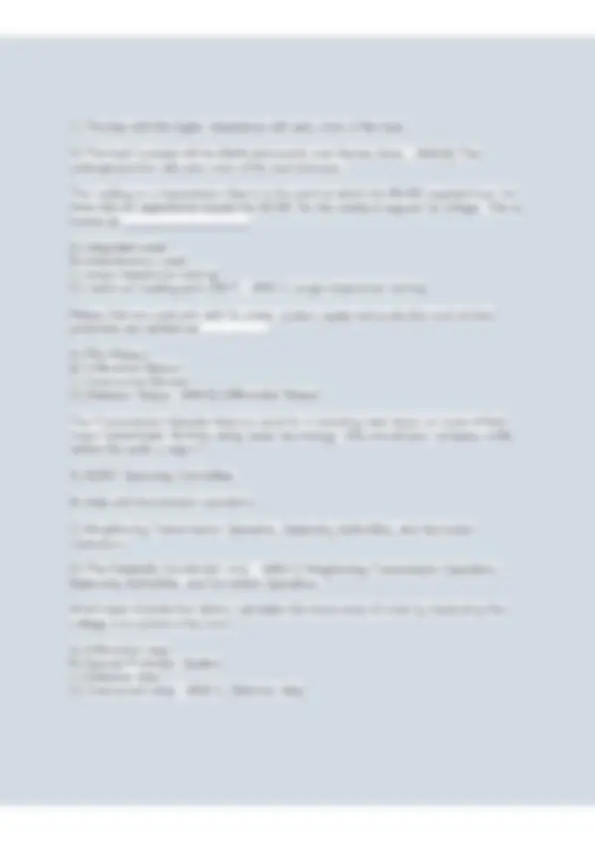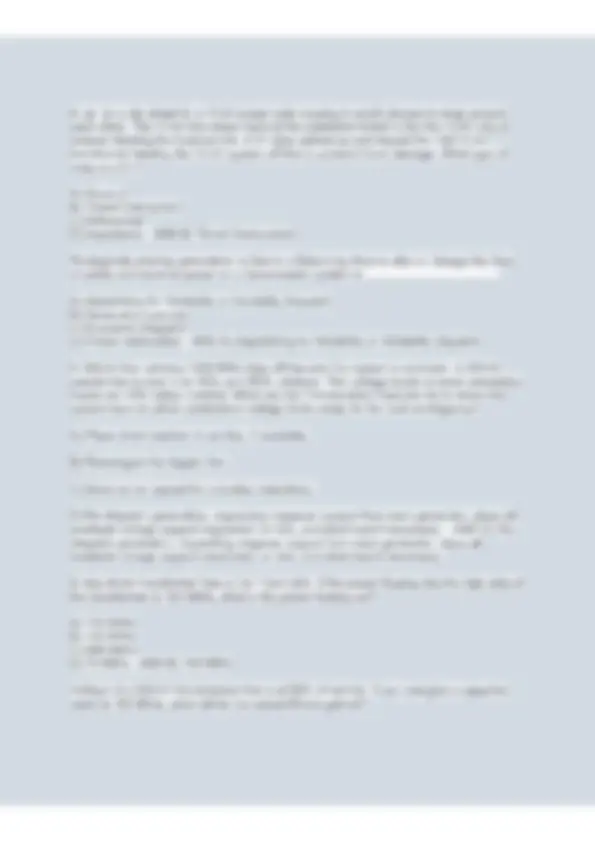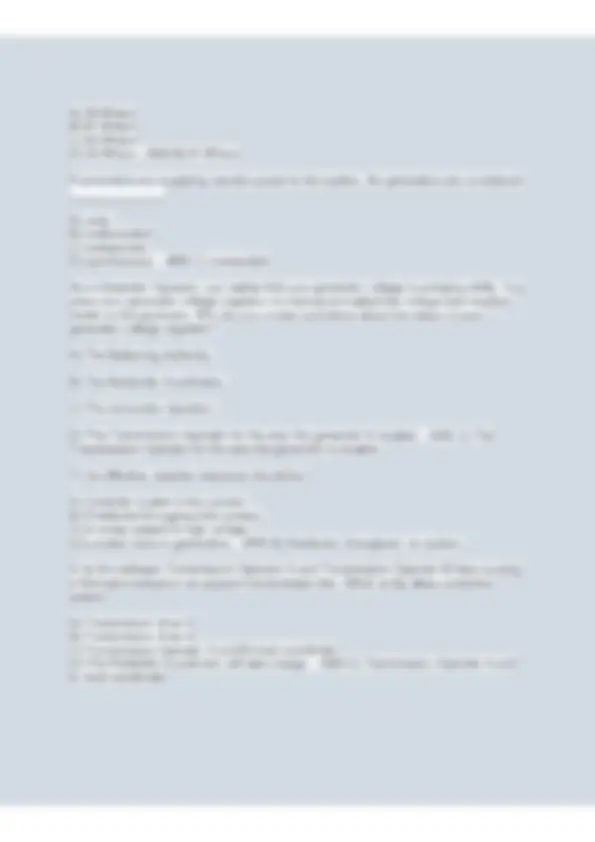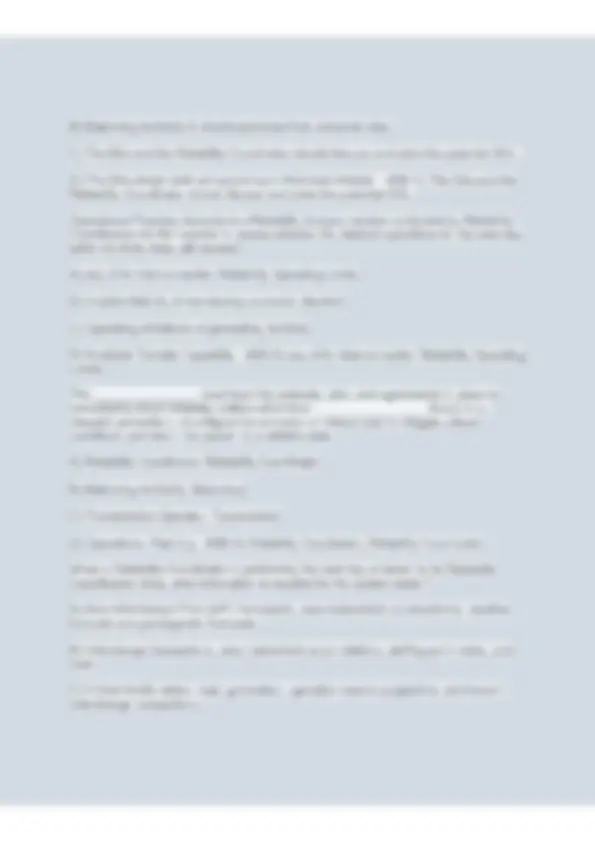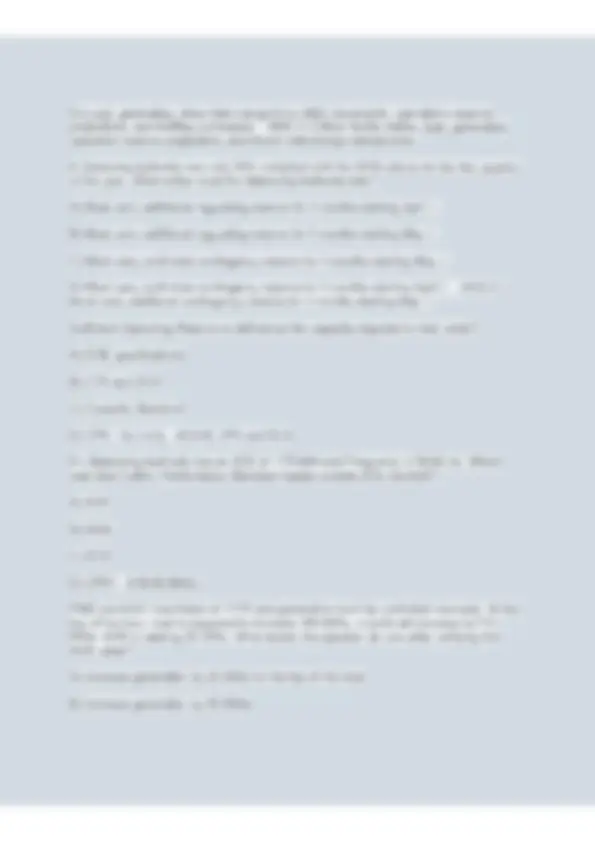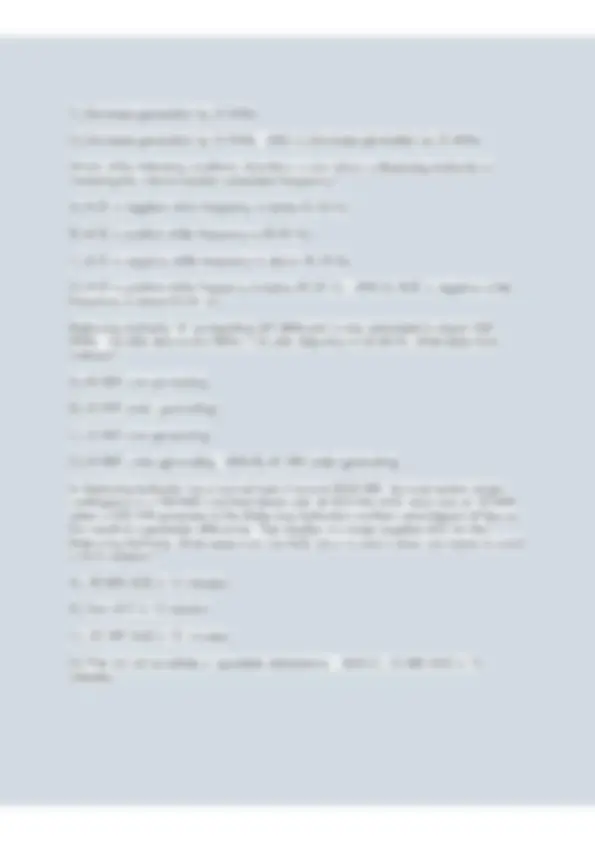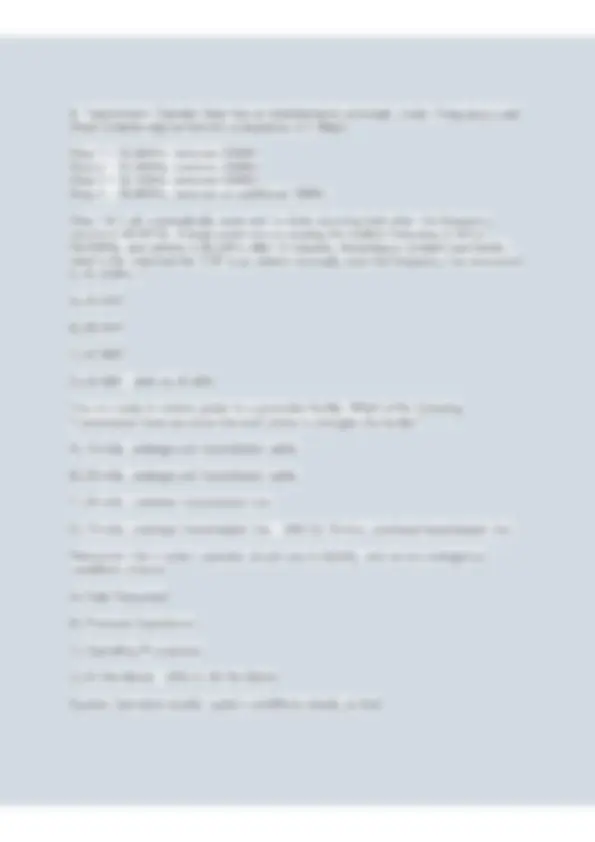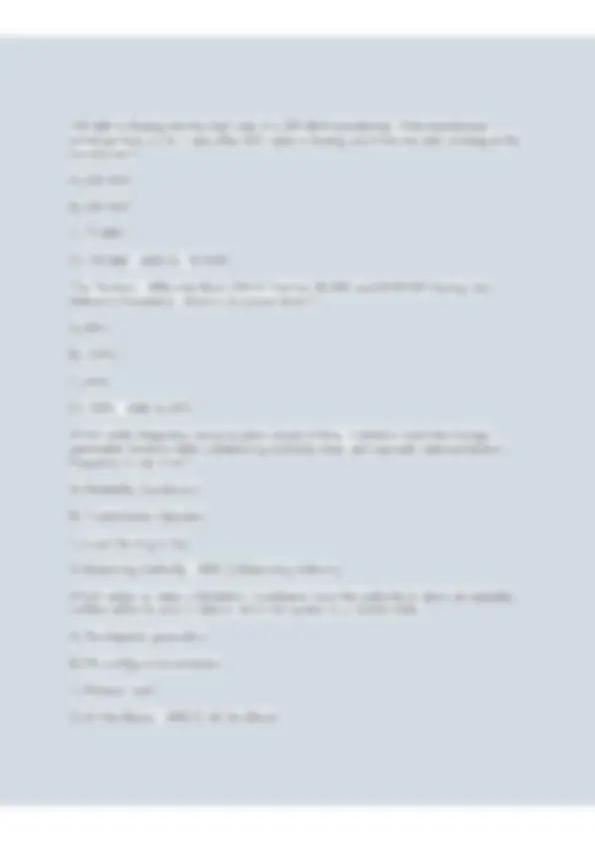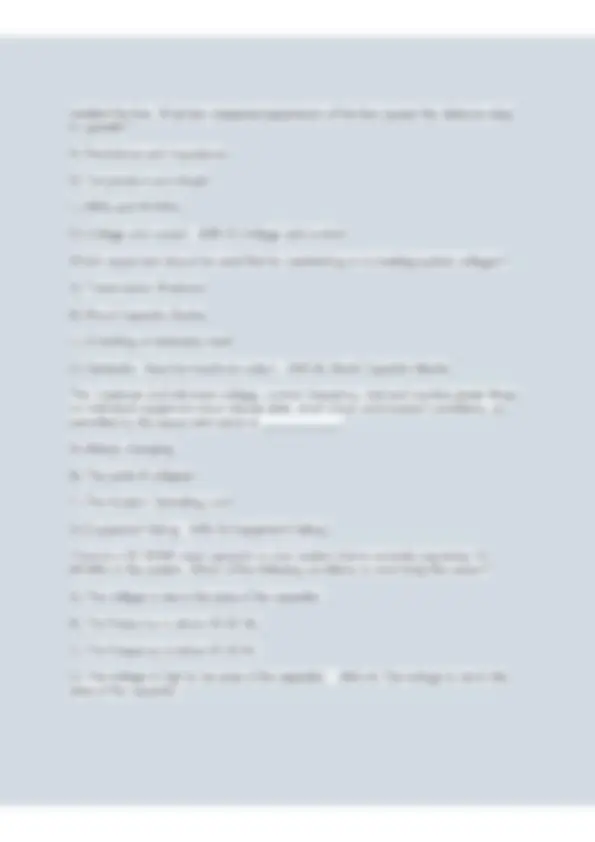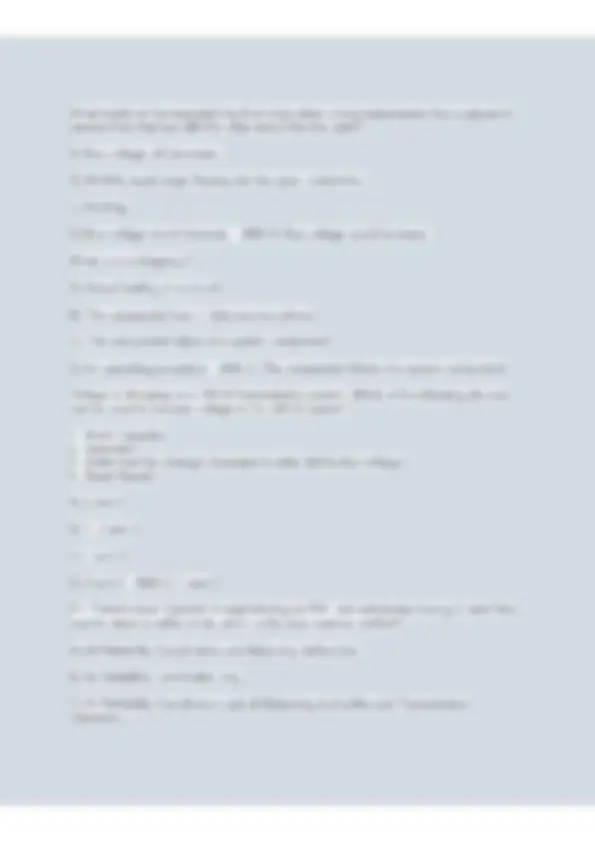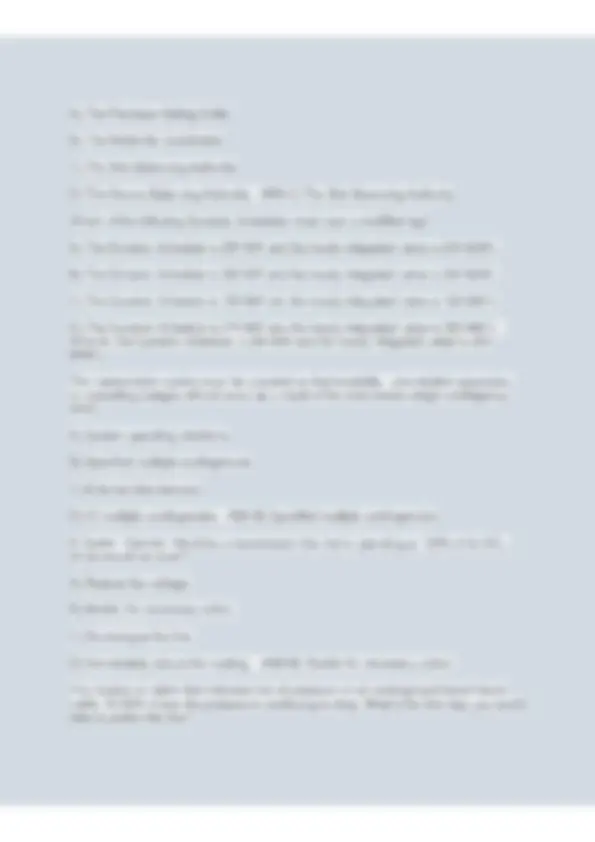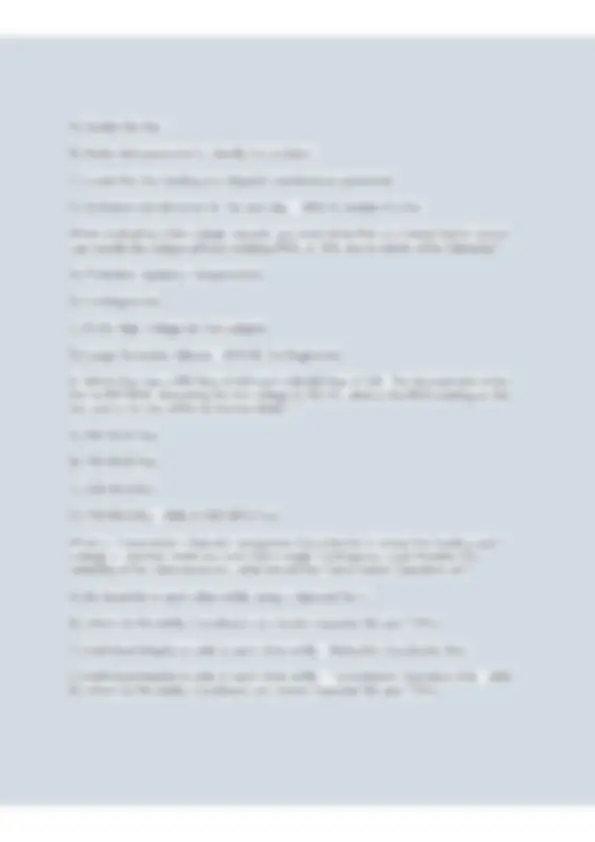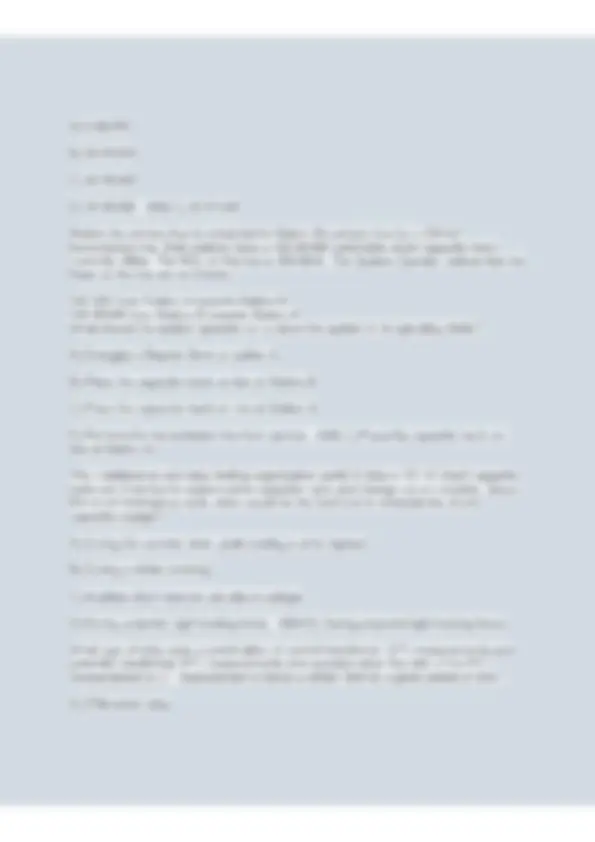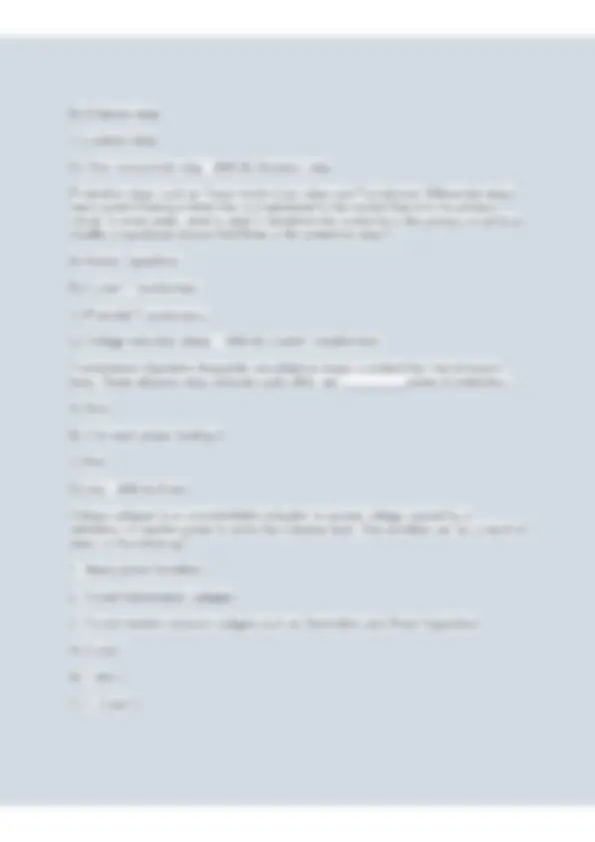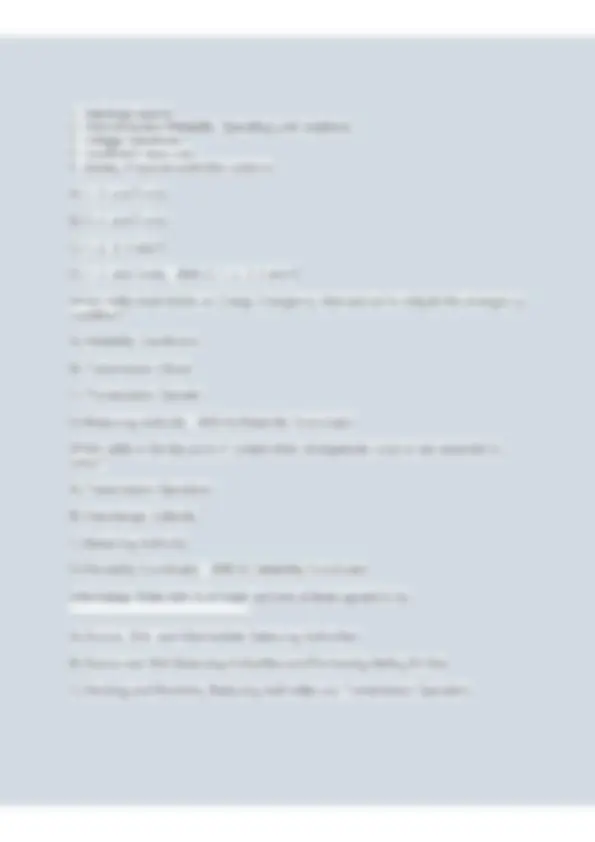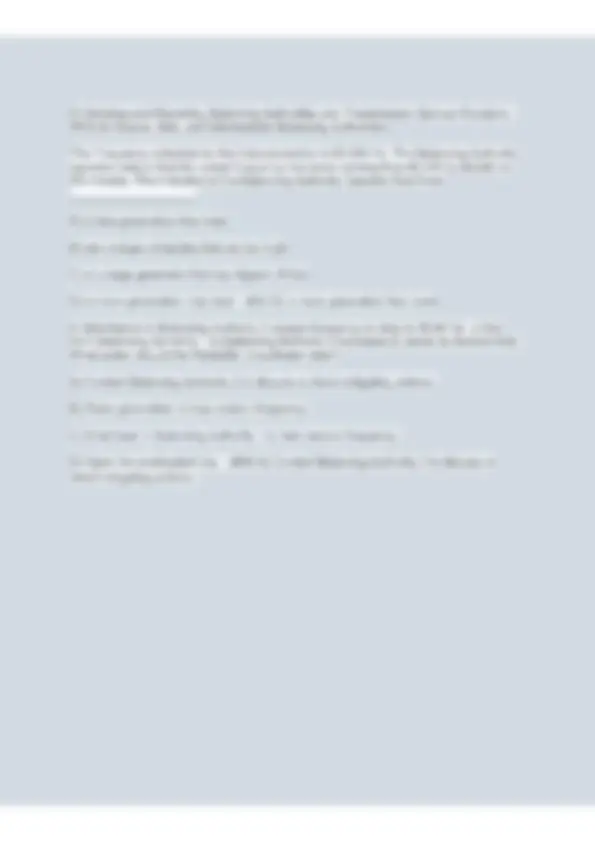Partial preview of the text
Download SOS NERC Certification Prep Reliability Exam Questions and Multiple choice with Correct An and more Exercises Engineering in PDF only on Docsity!
The Reliability Coordinator just informed you of a slow time error correction which will begin at the top of the next hour. Your EMS system will not let you change your scheduled frequency. Your Frequency Bias Setting is -100 MW/.1Hz. What action should you take? A) Increase Net Interchange Schedule by 20 MWs. B) Inform the Reliability Coordinator that you cannot participate in the time error correction. C) Decrease Net Interchange Schedule by 20 MWs. D) Increase Net Interchange Schedule by 10 MWs. - ANS-A) Increase Net Interchange Schedule by 20 MWs. A Balancing Authority has a sudden loss of a large block of load in its area. This loss will be seen instantaneously in the change of which of the following values? 1. Actual Net Interchange 2. Scheduled Frequency 3. Scheduled Net Interchange 4. Area Control Error A) 4 only B)18&3 C)1&4 D)3 &4-ANS-C) 1&4 Metered Data included in the calculation of ACE are: dynamic schedules, pseudo ties, actual frequency, and all A) Tie lines readings B) Generators output C) Scheduled frequency indications D) Transformer load - ANS-A) Tie lines readings Balancing Authority A is currently reading a system frequency of 60.00 Hz. Its Net Actual Interchange is +100 MW and its Net Scheduled Interchange is +200 MW. If Balancing Authority A's frequency bias setting is 100 MW/0.1 Hz, what is ACE? A) -100 B)0 C) 10 D) 100 - ANS-A) -100 A Balancing Authority has a Net Interchange Schedule of -250 MWs from 1200 to 1600 on a summer day. The Net Interchange Actual for those same hours respectively were - 230 MW, -275 MW, -250 MW and -270 MW. What was the Balancing Authority's Inadvertent Interchange for the 4-hour period? A) 6 MWs out B) 25 MWs in C) 25 MWs out D) 6 MWs in - ANS-B) 25 MWs in For the ACE equation to work properly, dynamic schedules, pseudo ties, frequency, and all must be metered. A B Cc D Generation Communications Transformers Tie lines - ANS-D) Tie lines If the frequency bias setting is set to a less negative value than the frequency response of a Balancing Authority and a frequency increase is caused by a sudden loss of load in an external balancing area, what will be the result? A) The ACE will be zero and will take no AGC action B) The ACE will be a negative value and AGC will increase generation C) The ACE will be a positive value and AGC will lower generation D)This will not affect the ACE - ANS-B) The ACE will be a negative value and AGC will increase generation If the frequency bias setting is less negative than the frequency response of a Balancing Authority and a frequency decline is caused by a sudden loss of generation in an external balancing area, what will be the result? A) The ACE will be a negative value and AGC will increase generation. D) Transmission System - ANS-A) Distribution system Under Frequency Load Shedding (UFLS) is to stabilize the imbalance between generation and load that has been created by a system disturbance. This is accomplished by A) Tripping generation first B) Voltage reduction on the distribution system. C) Shedding all load to arrest frequency D) Shedding load prior to generation tripping - ANS-D) Shedding load prior to generation tripping Failure to meet the DCS criteria of recovery within 15 minutes results in which consequence for a specified time period for the Balancing Authority's failure to recover? A) Increased Contingency Reserve requirements B) Decertification as a Balancing Authority C) Not allowed to supply regulation services D) Expulsion from the Reserve Sharing Group - ANS-A) Increased Contingency Reserve requirements A Balancing Authority foresees or is experiencing conditions where all available resources are committed to meet firm load, and firm transactions. The BA should request which level of the Energy Emergency Alerts? A) Energy Emergency Alert Level 2 B) Energy Emergency Alert Level 4 C) Energy Emergency Alert Level 1 D) Energy Emergency Alert Level 3 - ANS-C) Energy Emergency Alert Level 1 Preparations are being made to tie two islands together during restoration. Island "A" has a frequency of 58.95 Hz and Island "B" has a frequency of 59.97 Hz. What action should be taken to synchronize the two islands? A) Shed load in Island "B" B) Shed load in Island "A". C) Disable the Synch Check Relay. D) Increase generation in Island “B". - ANS-B) Shed load in Island "A". You experience a full system shutdown. You are in the process of restoring load and you are concerned about re-collapsing the system. Which is the best approach in the restoration process that will help ensure your system will be restored successfully? A) Maintain frequency between 59.5 HZ and 60.5 HZ. B) If the system has stabilized at below 60 HZ, shed 15% - 20% of the load to raise the frequency to 61 HZ. C) Avoid energizing loads in excess of 5% of the online generation capacity of the system. D) Operating reserves should be maintained to cover the largest generator currently in service. - ANS-C) Avoid energizing loads in excess of 5% of the online generation capacity of the system. In the event a Balancing Area experiences multiple contingencies occurring within of each other, it shall be treated as a single contingency. ) five minutes ) one minute or less ) fifteen minutes D) two minutes - ANS-B) one minute or less A B ie When coordinating under frequency load shedding and under frequency generator tripping the A) generators should trip before the UFLS B) load should not be shed during the process C) generators should trip after the UFLS D) breakers should open at the same time as the UFLS - ANS-C) generators should trip after the UFLS One of the functions of under frequency load shedding is to within an electrical island that may have been created by a system disturbance. A) balance generation and load B) establish balance between load and interchange C) stabilize balance between generators D) stabilize the Interconnection - ANS-A) balance generation and load A major transmission line has become overloaded and the transmission operator has taken actions to unload the line. However, the overload persists, and the equipment is now in imminent danger of damage. What is the next action to take? A) Separate from the Interconnection B) Disconnect the overloaded line and notify the RC and affected Transmission Operators. C) Request a Transmission loading relief procedure B) Turn all voltage regulators to the manual position. C) Contact the Regional Reliability Organization. D)Close any capacitor banks which are open. - ANS-A) Isolate the load. After declaring an NERC EEA Level 3, load goes higher than your generation resources, what is an effective tool in restoring generation to load balance? A B Cc D Firm Load Shed Exceeding emergency limits TLR Voltage Reduction - ANS-A) Firm Load Shed An 800 MW generator trips in a Balancing Authority external to your Balancing Authority Area. Which of the following indications would you expect to see in your area? A) Net Actual Interchange would decrease significantly. B) ACE would drop to approximately -800 MW. C) Frequency would drop, and ACE would remain relatively unchanged. D) Frequency would drop, and ACE would increase significantly. - ANS-C) Frequency would drop, and ACE would remain relatively unchanged. When is the only time voltage reduction for load relief is acceptable on the transmission system? A) When voltage on the distribution system is already low. B) It is acceptable anytime load relief is needed. C) When the system is separated from the Interconnection. D) When Interconnection frequency is above 60.00 Hz. - ANS-C) When the system is separated from the Interconnection. In system restoration, priority should be given to: A) Restoring customer load as quickly as possible. ) Reporting disturbance to NERC and DOE. ) Restoring auxiliary power to off-line generators. ) B Cc D) Restoring power to critical facilities. - ANS-D) Restoring power to critical facilities. If a Balancing Authority or Reserve Sharing Group is experiencing conditions where all available resources are committed to meet firm load, firm transactions, and reserve commitments, what does the deficient entity need to request their Reliability Coordinator to issue? A) Energy Emergency Alert Level 3 B) Energy Emergency Alert Level 1 C) Energy Emergency Warning D) Energy Emergency Alert Level 2 - ANS-B) Energy Emergency Alert Level 1 A Transmission Operator's Emergency Operating Plan states when voltages fall below .87 per unit (p.u.) or 87% of nominal voltage and remains at that level for a sustained period of 10 minutes or longer, manual load reduction actions are required. When the system voltage returns to .9 p.u. or 90% manual load disconnection is not required. If a generator trips off line within the BA and the nearby 230 kV system voltage immediately drops to 200 kV and remains at that level for the next 3 minutes. What is the BA required to do? A) Wait 7 minutes for the remaining generator AVRs to respond; close capacitor banks; adjust Transformer Taps. B) Immediately disconnect firm system load until the voltage returns to at least .9 p.u. Notify the RC of the amount of load disconnected. C) Immediately take actions to raise the voltage EXCEPT removing firm system load. Notify the RC and neighboring BA's. Prepare for manual load r - ANS-C) Immediately take actions to raise the voltage EXCEPT removing firm system load. Notify the RC and neighboring BA's. Prepare for manual load reduction if the voltage remains below .9 p.u. over the next 7 minutes. A condition when a Load-Serving Entity has exhausted all other options and can no longer provide its customers' expected energy requirements is referred to as ? A) Energy Emergency B) Energy deficiency C) Load shortage D) Energy shortage - ANS-A) Energy Emergency You are currently in the early stages of restoration with 600 MWs of synchronized generation. There is 200 MWs of spinning reserve available. To maintain acceptable frequency control, what is the largest block of load that can be restored at one time? A) 10 MWs B) 20 MWs A simple power system is composed of three transmission lines that connect the generation area to the load area. The three lines are different lengths, but each line has the same impedance. Each line is initially loaded at 200 MW. The SOL of each line is 400 MW. If one of the three lines trips, what will be the loading on the shortest remaining line and will the SOL of either remaining line be violated? A) 400 MW/Yes B) 400 MW/No C) 300 MW/Yes D) 300 MW/No - ANS-D) 300 MW/No During a lightning storm, a fault on a transmission line results in the transmission relay operating and locking-out. The transmission line cannot be returned to service. After running a contingency analysis, the Transmission Operator realizes that if another transmission line relays, there could be cascading outages into a neighboring system. Which of the following actions is appropriate for the Transmission Operator? A) Reduce transmission voltages by 5% to reduce customer demand. B) Notify others in the Interconnection of the situation via an Interconnection-wide telecommunications system. C) Continue operations without notifying anyone but try to reduce system loading. D) Prepare a disturbance report and forward it to the Reliability Coordinator. - ANS-B) Notify others in the Interconnection of the situation via an Interconnection-wide telecommunications system. A Generator Operator has some vibration problems with a SOOMW coal fired steam generator. As the result of the vibration problems the Generator Operator has to set the maximum reactive power production for that unit at 25 Megavar instead of the normal 200 Megavar. Who should the generator operator notify as the result of this problem? A) Transmission Operator B) System Coordinator C) Department of Energy (DOE) D) Regional Reliability Organization - ANS-A) Transmission Operator A high voltage transmission line was scheduled out for routine maintenance several weeks in advance. On the scheduled outage date, field personnel call to inform the system operator that they will be taking the line out of service. Bad weather the previous day has forced other outages. What should the system operator do? A) Wait until peak is over to make a decision B) Run a power flow study to determine the effects of this line outage C) Do not allow the outage D) Allow the outage because it was scheduled in advanced - ANS-B) Run a power flow study to determine the effects of this line outage Interconnection frequency is 60.20 Hz. Your ACE is a large positive value and your AGC is pulsing your units down. What should you do? A) Suspend AGC and investigate. B) Place AGC in flat tie line control. C) Leave AGC in operation as your units respond. D) Place AGC in constant frequency control. - ANS-C) Leave AGC in operation as your units respond. Which of the following is the most common effect of a Geomagnetic Disturbance on the power system? A) Increase static electricity B) Transformer cores becoming saturated C) Generator output varies D) Abnormal VAR direction - ANS-B) Transformer cores becoming saturated In a power system, which type of power provides indication of voltage problems, is critical for support of heavily loaded transmission lines, and is necessary to have sufficient dynamic reserves in preparation for a contingency? A) Solar Power B) Real Power C) Reactive Power D) Apparent Power - ANS-C) Reactive Power You are a transmission operator and you have several large generators operating at full load on the western portion of your transmission system with 34 kV and 230 kV transmission lines connecting the generators to the larger metropolitan and Industrial areas in the eastern portion of your transmission system. You realize by SCADA indications that there is a large power angle approaching 88 degrees between some of the sending busses at the generation sites and the receiving buses around the load areas. You realize that the slightest contingency on the system could elevate the power angle above 90 degrees which could cause the generation and load areas to lose synchronism. What would be some of your first immediate responses to prevent this from happening? A) Raise the bus voltage at the receiving buses and at the sending buses, if possible. Then, have the balancing operator provide additional generation on line on the - ANS-A) Raise the bus voltage at the receiving buses and at the sending buses, if possible. Which of the following is NOT a requirement of the Reliability Coordinator concerning GMDs? A) Identify conflicts in their area's Transmission Operator plans B) Specify actions to be included in the Transmission Operator's GMD Operating Procedures C) Disseminate information concerning GMDs to entities in the Reliability Coordinator's Operating Plan D) Coordinate the GMD Operating Procedures of Transmission Operators in their area - ANS-B) Specify actions to be included in the Transmission Operator's GMD Operating Procedures A transformer rated at 50 MVA is currently carrying 30 MW of load. At this load, what is the maximum allowable MVAR flow through the transformer? A) 50 MVAR B) 30 MVAR C) 40 MVAR D) 0 MVAR - ANS-C) 40 MVAR System Operators shall act to maintain the reliability of its Area through actions of their own or by issuing Operating Instructions, such as, canceling outages, transmission reconfiguration, generation re-dispatch and load shed for what purpose? A) Prevent power flow B) Prevent uncontrolled separation and Cascading outages C) Serve interchange transactions D) Serve commercial loads - ANS-B) Prevent uncontrolled separation and Cascading outages When two identical A/C generating units are operated in parallel on governor control, and one machine has a 5% droop and the other has a 10% droop, the unit with the greater governor droop will... A) No adjustment for frequency changes. B) Share load equally with the other machine. C) Tend to take the greater portion of load changes. D) Tend to take the lesser portion of load changes. - ANS-D) Tend to take the lesser portion of load changes. A conductor is rated for 180 MVA, the current transformer at one end is rated at 160 MVA and the bus is rated at 200 MVA. What is the MVA limit for this transmission line? A) 160 MVA B) C) 180 MVA D) 200 MVA - ANS-A) 160 MVA If a high voltage current (HVDC) tie is on the Scheduling Path for a transaction, the shall coordinate the Interchange Schedule with the Transmission Operator of the HVDC tie. A) Transmission Service Provider at the sending and receiving ends of the tie. B) Source and Sink Balancing Authorities C) Sending and Receiving Balancing Authorities D) Transmission Operators at the sending and receiving ends of the HVDC tie. - ANS- C) Sending and Receiving Balancing Authorities Balancing Authorities on the Scheduling Path shall be responsible for assessing and approving or denying the Interchange Transaction based on which of the following: 1. Transaction Magnitude 2. Scheduling path 3. OASIS reservation 4. Ramp rate A)1,3 and 4 B)1,2and3 C)2,3 and 4 D) 1, 2 and 4 - ANS-D) 1, 2 and 4 Who must approve a Reliability Adjustment Arranged Interchange before it becomes Confirmed Interchange? A) Only the Source and Sink Balancing Authorities associated with the Interchange B) The Reliability Coordinator approves all Reliability Adjustment Arranged Interchange C) All Balancing Authorities involved in the Interchange D) Each Balancing Authority and Transmission Service Provider associated with the Interchange - ANS-A) Only the Source and Sink Balancing Authorities associated with the Interchange B) The Purchasing-Selling Entity responsible for tagging the schedule C) Transmission Service Provider D) Source Balancing Authority - ANS-B) The Purchasing-Selling Entity responsible for tagging the schedule The Transmission Operator and Balancing Authority shall develop, maintain, and implement one or more Reliability Coordinator-reviewed Operating Plan. What is the purpose of Operating Plans? A) Update Regional Reliability Organization and NERC B) Notify all Reliability Coordinators in NERC C) Notify the Reliability Coordinator D) To address and mitigate operating Emergencies - ANS-D) To address and mitigate operating Emergencies Which of the following would not be considered in determining ratings on transmission facilities? A) Power Transfer Distribution Factor B) Thermal limits C) Voltage limits D) Short-term loading limits - ANS-A) Power Transfer Distribution Factor When would be the best time to schedule a capacitor bank outage? A) During projected light loading. B) During winter peak loading. C) During summer peak loading. D) When all the other reactive sources are scheduled for an outage. - ANS-A) During projected light loading. Two lines of the same construction are both connected to Bus A and are both open at the other end. Line #2 is twice as long as Line #1. The voltage at the open end of Line #1 is 3% higher than the voltage at Bus A. What can you conclude about the voltage at the open end of Line #2? A) 3% lower than Bus A. B) More than 3% lower than Bus A. C) 3% higher than Bus A. D) More than 3% higher than Bus A. - ANS-D) More than 3% higher than Bus A. In a system that is more capacitive than inductive, the current sine wave will lead the voltage sine wave which tends to voltage. A) decrease load B) raise C) have no effect D) lower - ANS-B) raise A Transmission Operator experiences the unexpected loss of an internal 230 kV transmission line. This line will be out of service for more than two hours. The expected system peak will also be in the next two hours. Which of the following actions should the Transmission Operator take? A) Prepare for the next contingency B) Reduce the expected peak demand C) Contact neighboring entities D) Monitor the system until the line is back in service - ANS-A) Prepare for the next contingency When or under what condition should the Transmission Operator disconnect from the interconnection? A) When their system is in severe violation of an IROL or SOL. B) When ordered to by the NERC. C) Only if directed by the Reliability Coordinator D) When the frequency is below 57 Hz. - ANS-A) When their system is in severe violation of an IROL or SOL. The system is heavily loaded. Adjusting an under-load tap changer (ULTC) tap setting to support low side voltage will move MVArs from the primary (high) side to the secondary (low) side of the transformer. As the MVArs move from the high side to the low side of the transformer, what will be the result of a tap change on the ULTC to raise low side voltage as the high and low side voltages become closer together in magnitude? A) The high side voltage will increase. C) The line with the higher impedance will carry more of the load. D) The load increase will be distributed evenly over the two lines. - ANS-B) The underground line will carry more of the load increase. The loading on a transmission line is to the point at which the MVAR supplied from the lines natural capacitance equals the MVAR the line needs to support its voltage. This is known as A) integrated peak B) instantaneous peak C) surge impedance loading D) maximum loading point (MLP) - ANS-C) surge impedance loading Relays that are used primarily for power system equipment protection and not line protection are defined as A) Pilot Relays B) Differential Relays C) Overcurrent Relays D) Distance Relays - ANS-B) Differential Relays The Transmission Operator that you work for is installing new relays on some of their major transmission tie lines using newer technology. Who should your company notify before the work is begun? A) NERC Operating Committee. B) Adjacent transmission operators C) Neighboring Transmission Operators, Balancing Authorities, and Generator Operators. D) The Reliability Coordinator only. - ANS-C) Neighboring Transmission Operators, Balancing Authorities, and Generator Operators. Which type of protective device calculates the impedance of a line by measuring the voltage and current of the line? ) Differential relay ) Special Protection System ) Distance relay ) A B Cc D) Overcurrent relay - ANS-C) Distance relay A car on a city street hit a 13 kV power pole causing A and B phases to wrap around each other. The 13 kV line relays back at the substation failed to trip the 13 kV circuit breaker feeding the troubled line. A 51 relay picked up and tripped the 138/13 kV transformer feeding the 13 kV system off line to protect it from damage. What type of relay is a 51? A) Ground B) Timed Overcurrent C) Differential D) impedance - ANS-B) Timed Overcurrent Strategically placing generators on line in a Balancing Area to alter or change the flow of active and reactive power on a transmission system is A) dispatching for Reliability or Reliability Dispatch B) Generation Lambda C) Economic Dispatch D) Power reallocation - ANS-A) dispatching for Reliability or Reliability Dispatch A 345 kV line carrying 1250 MWs trips off line and the reason is unknown. A 230 kV parallel line is now in an SOL and IROL violation. The voltage levels at some substation buses are 10% below nominal. What can the Transmission Operator do to return the system back to within established voltage limits ready for the next contingency? A) Place shunt reactors in service, if available. B) Reenergize the tripped line. C) Send out an appeal for voluntary reductions. D) Re-dispatch generation, requesting megavar support from each generator, place all available voltage support equipment on line, and shed load if necessary. - ANS-D) Re- dispatch generation, requesting megavar support from each generator, place all available voltage support equipment on line, and shed load if necessary. A step-down transformer has a 2 to 1 turn ratio. If the power flowing into the high side of the transformer is 140 MWs, what is the power flowing out? A) 150 MWs B) C) 280 MWs D) 70 MWs - ANS-B) 140 MWs Voltage of a 345 kV transmission line is at 90% of normal. If you energize a capacitor rated at 100 MVar, what will be the actual MVars gained? 
